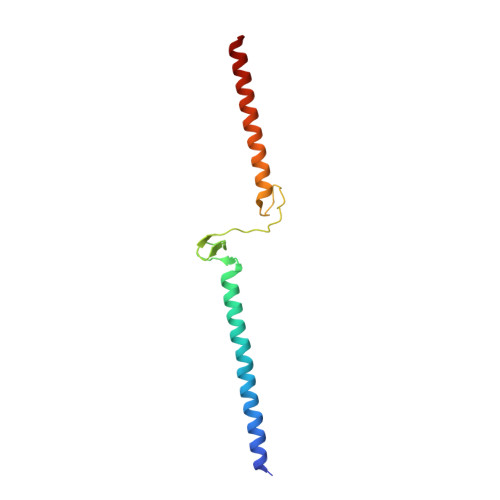A New Expression System for Protein Crystallization Using Trimeric Coiled-Coil Adaptors.
Hernandez Alvarez, B., Hartmann, M.D., Albrecht, R., Lupas, A.N., Zeth, K., Linke, D.(2008) Protein Eng Des Sel 21: 11
- PubMed: 18093992
- DOI: https://doi.org/10.1093/protein/gzm071
- Primary Citation of Related Structures:
3ZMF - PubMed Abstract:
We repeatedly experienced difficulties in obtaining pure protein of a defined oligomeric state when expressing domains that consist partially or entirely of coiled coils. We therefore modified an established expression vector, pASK-IBA, to generate N- and C-terminal fusions of the cloned domain in heptad register with the GCN4 leucine zipper. GCN4 is a well-characterized coiled coil, for which stable dimeric, trimeric and tetrameric forms exist. To test this expression system, we produced a series of constructs derived from the trimeric autotransporter adhesin STM3691 of Salmonella (SadA), which has a highly repetitive structure punctuated by coiled-coil regions. The constructs begin and end with predicted coiled-coil segments of SadA, each fused in the correct heptad register to the trimeric form of GCN4, GCN4pII. All constructs were expressed at high levels, trimerized either natively or after refolding from inclusion bodies, and yielded crystals that diffracted to high resolution. Thus, fusion to GCN4pII allows for the efficient expression and crystallization of proteins containing trimeric coiled coils. The structure of short constructs can be solved conveniently by molecular replacement using the known GCN4 structure as a search model. The system can be adapted for constructs with dimeric or tetrameric coiled coils, using the corresponding GCN4 variants.
- Department Protein Evolution, Max Planck Institute for Developmental Biology, Spemannstr. 35, 72076 Tübingen, Germany.
Organizational Affiliation:
















